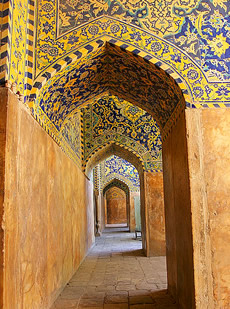 |
| Isfahan (Persia) |
In 1592 Shah Abbas I made Isfahan the capital of the Safavid Empire. In an earlier era, Isfahan had been the capital of the Seljuk Empire, but under Shah Abbas the city became a major economic and cultural center or as the Persian saying went, “Isfahan is half the world.”
The Masjid-i Jami, or Friday Mosque (1088), an earlier Seljuk building, dominates one section of the city. This mosque is known for its brick domed chambers and stucco mihrab (prayer niche). Under Shah Abbas, a huge open square, the Maydan-i Shah, with a polo field the favorite amusement of the Safavid court, became the centerpiece of the city. The square was surrounded by Safavid buildings.
  |
The Masjid-i Shaykh Lutfallah (1602) stands on one side; a vast covered bazaar anchors another, and the monumental Masjid-i Shah (1612–13) dominates a third side. An elaborately decorated blue tiled dome with Qu’ranic inscriptions in finely wrought calligraphy
The Ali Qapu, a vast royal palace complex, is the main building on the fourth side of the square. The palace’s second-story porch, covered by a wooden roof supported by slender columns, overlooks the square. From this porch, the shah and his court could watch polo games and other state ceremonies.
 |
| Persian floral patterns |
The Safavids became known for Persian carpets with floral patterns and center medallions as opposed to the geometric designs favored by tribal artisans. Safavid artists also excelled in the painting of miniatures and illustrated manuscripts, many of which included figural representations that were rare in Arab or Ottoman works.